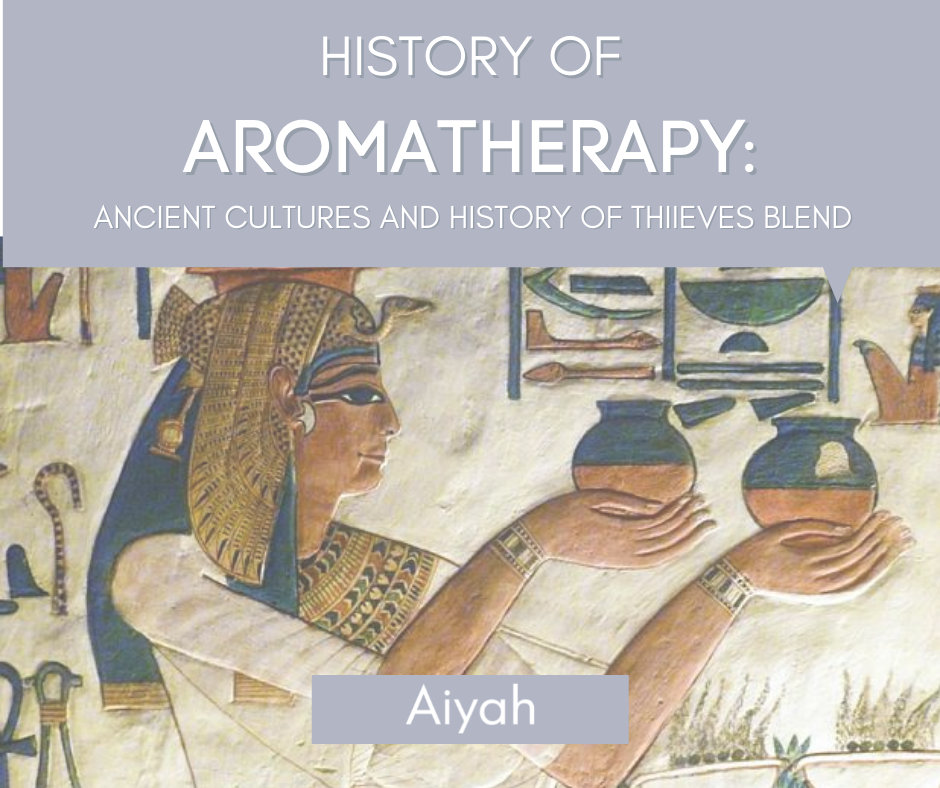The use of essential oils has been increasing in popularity in the past couple of decades. It’s resurgence is more widespread nowadays due to social media, which allows experts and enthusiasts alike to share the helpful usage and versatility of essential oils. The use of essential oils, however, has been going on for centuries. In fact, records of carbon dating from cave paintings at Lascaux in France suggest the use of essential oils in everyday life go as far back as 18,000 B.C.E.

In this blog, we will talk about the history of Aromatherapy, how it was used in different ancient civilizations, and how it has evolved through time. We will also discuss the interesting history of Thieves blend and how it is used today.
History of Aromatherapy
Aromatherapy has been used in many cultures around the world because of its medicinal, therapeutic, and cosmetic properties. Records show that the most popular civilizations back then used essential oils in their rituals and healing ceremonies, like the Egyptians and Chinese. Greeks and Romans used essential oils for personal care and for various cosmetic purposes, much of which is still used in today’s society.
Egyptians: The Egyptians are one of the civilizations that really harnessed the use of essential oils. It is very important to their culture as they associate several oils to their gods, one of which was Nefertem - the god who protected perfumes, salves and anointing oils. Essential oils are so valuable to their culture that they are usually reserved for Pharaohs and priests. One of the most popular users of essential oils in the ancient times was Cleopatra.
The deep connection between Egyptian and essential oils was discovered through the process of learning about their mummification rituals. In ancient times, Egyptians used cedarwood and myrrh oil in their mummification process. It’s also used to preserve their papyrus scrolls. Bottles with essential oils were found in the tombs of their pharaohs as they believed that the spirits in the afterlife could still enjoy their fragrant and medical properties.

Greek and Romans: Their use of essential oils and aromatic fragrances started when they conquered the Egyptian empire. They absorbed all the knowledge of essential oils and experience of extracting the oils from plants. Even Hippocrates, who is regarded as the father of modern medicine, recognized the benefits of using essential oils in his practice. He prescribed pleasant-smelling essences to his patients and used hot wraps with essential oils to cure certain illnesses.
Around the same time, Romans heard of essential oils from Greek medicine. They were impressed by the power of fragrances and also used them enthusiastically in aromatherapy. Essential oils were mainly used for their healing properties. They used mint leaves to clean their hospitals. Its use eventually evolved that they also use it for cosmetic reasons. Romans used scented oils to their hair, bodies, clothes and even the walls of their homes. During this period as well, they discovered an efficient distillation process was developed for their extraction.

Chinese and Indians: It was reported that the Chinese used herbs and aromatic plant essences at the same time as the Egyptians. According to Traditional Chinese Medicine (TCM), essential oils represent the “jing” of the plants. The theory states that essential oils contribute to spiritual, mental, and physical development because the jing of the plant resonates with the jing of the body.

Traditional Indian medicine, or Ayurveda, has a 3,000-year history of incorporating essential oils into healing elixirs. The origins of these traditional system of medicine are linked with myths and mythology. It is believed that the Gods themselves handed these techniques to the Sages and wise men for the benefits of mankind. Vedic literature lists more than 700 substances including cinnamon, ginger, myrrh and sandalwood as effective for healing. In fact, much later, during the outbreak of the Bubonic plague (also called as Black Death), Ayurveda practices and treatments were used successfully to replace ineffective antibiotics.

Use of Aromatherapy in Persian Civilization and in the Middle Ages: Essential oils became popular again because of the renowned invention of the Persian doctor and alchemist Ibn Sina, known to us as Avicenna. He invented a condensing coil for steam distillation which helped to make distillation of essential oils become much more effective and better. Ibn Sina’s “Canon of Medicine” remained the most influential medical textbook until the 16th century. In this book, Avicenna recommended the use of essential oils and infusions to treat physical and mental illnesses.
The term aromatherapy was introduced by the French perfumer René-Maurice Gattefossé in the early 1920s. He accidentally discovered the effectiveness and the medicinal properties of essential oils. While doing chemical experiments, Gattefossé accidentally burned his arm. In such haste, he reached for the nearest bottle of liquid which luckily was Lavender oil. After pouring the essential oil, he noticed that the pain subsided immediately, the burns healed fast and it did not leave any scars. From then on, he dedicated his life to pure natural oils for therapeutic, medical and aesthetic purposes. His book “Aromatherapy”, published in 1939, is still consulted today.

Aromatherapy today: In the next decades that followed, interest has grown in the therapeutic power of essential oils. Aromatherapy today is used to treat mood disorders and illnesses as well as to alleviate illnesses and increase a person’s wellbeing. Aromatherapy is now regarded as a form of Phytotherapy or plant-based healing. It is being taught in some medicine schools like in France and England, and oils are more frequently being used by doctors in many hospitals. The majority of people in today’s society have access to plant essences and it’s no longer reserved to the upper classes.

HISTORY OF THIEVES BLEND
Thieves blend is a blend of clove, lemon, cinnamon, eucalyptus radiata, and rosemary. This famous blend is consistently used in many households today. But the origin of this blend is really interesting.

In the year 1413, the Black Death devastated a large portion of France. During this time, four thieves were going around several houses, stealing from the sick and dying. Once captured, the authorities and doctors were intrigued. They wondered how these thieves went from house to house without contracting the infamous disease. This crime was punishable by being burned alive. The judge proposed if they share their secret, he would spare them of their punishment. The thieves shared that they were perfume and spice merchants. Because of unemployment, they had no choice but to rob houses to survive. They concocted an essential oil recipe that when applied to their hands, ears, temples, and feet, it will keep them safe from infection. The judge stayed true to his word. The men were not burned alive, but instead they were hanged for their crimes.
From then on, the doctors who treated the sick rubbed the herbal infusion on their bodies and wore beak-like masks stuffed with cloths containing this special blend. Thieves is now a very popular blend that has a number of benefits, a few of which include:
- Eliminates airborne bacteria
- Supports your immune system
- Kills toxic molds, 99.96% of bacteria, and viruses
- Works with the body’s natural defenses
- Supports oral health
- Can be used to clean and eliminate odors

